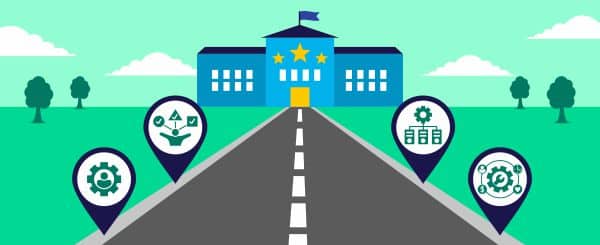Organic SEO Drives Tangible Results in Higher Ed
When it comes to marketing strategies in higher education, search engine optimization (SEO) often sits quietly in the back of the classroom, patiently raising its hand while flashier tactics like social media and email campaigns hog the spotlight. But here’s a little secret: SEO isn’t just another buzzword — it’s a powerhouse player in boosting student enrollments.
Imagine SEO as the quiet but brilliant student who, once you notice them, offers profound insights. By optimizing their online presence through SEO tactics, colleges and universities can significantly increase their visibility to prospective students. This isn’t about attracting clicks for the sake of clicks; it’s about connecting the right students with the right programs and organically growing enrollments through smart, targeted content.
In this article, we’ll dive into how a well-crafted organic SEO strategy isn’t just a good idea — it’s an essential ingredient for enrollment success. We’ll explore how tweaking your institution’s digital presence can lead not only to better search engine rankings but also to real chairs filling up in real classrooms.
Intro to SEO
SEO is the science of enhancing your website’s ability to stand out to people who are searching for products or services related to your institution in Google, Bing, and other search engines. The goal is simple: to increase your site’s visibility in search results, which helps more people find your organization.
Understanding organic SEO is crucial because it directly influences both traffic to your site and the potential for conversions among site visitors. By optimizing elements like keywords, meta tags, and link building (we’ll break these down later in the article), you can make your website more attractive not only to search engines but also to prospective students. Essentially, SEO helps your site speak the language of search engines, and, by doing so, it drives more relevant traffic to your site that translates into more enrolled students.
Understanding How SEO Impacts Organic Enrollment
While paid ads, social media posts, and public relations outreach are vital components of a robust marketing strategy, they often provide a temporary boost in visibility. These methods can introduce your brand to a wide audience quickly, but they don’t always guarantee long-term, sustainable growth.
For lasting success, an investment in organic SEO is essential. It builds a foundation that continuously attracts prospective students to your institution through organic search results, long after a paid campaign has ended.
SEO ensures that, once students find your site, they keep coming back, driven by relevant, engaging content and a user-friendly experience that supports their educational journey. This organic retention strategy not only enhances students’ loyalty to your brand but also solidifies your institution’s reputation as a thought leader in higher education, visible and accessible right at the top of the search results.
Organic Visibility
If your institution’s pages aren’t ranking for the right keywords, it’s like having a hidden treasure with no map. Students simply won’t be able to discover your programs. Ensuring your website ranks well for specific keywords is crucial to making your educational offerings visible and accessible to potential students searching for information about their next academic adventure.
Improved Student Experience Through CRO
Pages created using conversion rate optimization (CRO) — which involves the strategies and techniques employed to improve website elements in order to increase the rate at which visitors convert into customers — provide a user experience (UX) that is positive and user-friendly, ensuring that students can easily find the information they need.
This streamlined approach not only enhances the experience of prospective students who visit your site but also significantly boosts the likelihood that those students will take the next step in their educational journey with your institution.
Increased Credibility and Trust Through E-E-A-T
Google uses a framework centered on experience, expertise, authoritativeness, and trustworthiness, what it refers to as E-E-A-T, to assess the quality of content on the web. Essentially, the more your content reflects the E-E-A-T qualities, the higher Google will rank it in search results.
For example, incorporating real insights through faculty blurbs and student testimonials enhances your content’s credibility and strengthens its appeal to prospective students. This authentic touch helps build trust with prospective students and can be a decisive factor in their decision to enroll in your program.
Content Creation and Optimization
A well-crafted content strategy that addresses every stage of the student journey steers potential students toward enrollment. Creating targeted content that answers students’ specific questions and needs at each stage — from initial awareness to consideration and decision — allows your institution to effectively guide students closer to conversion.
Additionally, program pages with finely tuned keywords play a critical role in boosting your visibility online. When these pages are optimized for relevant search terms, they attract more organic traffic, placing your programs right in front of the students who are most likely to be interested in them. It’s also important to build interlinks that connect your program pages to one another, as well as backlinks to your pages from external sites.
This strategic alignment of content and SEO not only enhances your site’s discoverability but also increases the likelihood of converting casual browsers into enrolled students.
Keyword Research
Keywords are the bedrock of any effective organic SEO strategy, acting as the foundational elements that connect potential students’ searches to your content. Through keyword research using tools like Ahrefs, institutions can identify the specific terms and phrases prospective students use when looking for educational opportunities.
This research is not just about finding the most-searched terms; it’s about understanding the intent behind the searches and tailoring your content to meet those needs.
For example, just because the term “nursing degree” is searched for thousands of times per month, that doesn’t mean it’s the best keyword for your specific program. You might have better results by getting more specific and using a term with less competition, like “online RN to BSN program.”
Content Gap Analysis
Analyzing your competitors’ websites plays a pivotal role in refining your content strategy by highlighting gaps in your own content. This process, known as content gap analysis, can also be performed with a tool like Ahrefs. It involves thoroughly examining what your competitors are offering and identifying areas where they excel or fall short.
When you gain an understanding of these dynamics, you can pinpoint opportunities where your content can be enhanced or differentiated to better meet the needs of prospective students. This strategic insight not only helps you craft content that stands out but also ensures the content is comprehensive and compelling, covering areas that competitors might have overlooked.
Educational Blogging
Educational blogs covering topics like curriculum specifics, program outcomes, and career opportunities are used to effectively guide prospective students through the student journey funnel.
This targeted content helps students make informed decisions by clearly illustrating what they can expect from certain educational and professional paths. Strategic blogging not only informs but also builds trust in your institution as a reliable source of educational insight.
Styles of Content
In the landscape of organic content creation, different styles cater to different needs and preferences, increasing the engagement and understanding of prospective students. Here are some styles your institution could try out:
- Visual content: Visual content utilizes images, videos, and graphics to capture students’ interest and convey information quickly. This modality helps engage users who prefer visual learning or need a quick grasp of complex concepts.
- Informational content: Informational content provides data, facts, and insights in a straightforward format. It provides the ideal delivery of detailed and accurate information about programs, admissions, careers, or educational policies.
- Interactive content: Interactive content includes quizzes, polls, and interactive maps or tools that engage users by allowing them to participate actively. This format is particularly useful for prospective students exploring various aspects of campus life or academic programs.
- Longform content: Longform content delves deeply into subjects (like this article) through detailed articles or posts, offering a thorough exploration of topics such as career outcomes or advanced study areas. Longform content is valuable for SEO and helps establish authority by covering topics comprehensively.
- Infographic content: Infographic content combines visuals and text to summarize complex data or information in a digestible and attractive way. Infographics are excellent for conveying statistics about student success, program effectiveness, or demographic studies.
Audits and Analytics
While content is important, a comprehensive organic SEO strategy begins with a thorough audit of your website’s technical health, ensuring that all its technical elements are optimized for peak performance.
Utilizing analytics is crucial to understanding how users interact with your pages, providing valuable insights that guide further improvements. This process helps you not only boost your site’s visibility but also enhance the user experience, making your educational content more accessible and effective.
Technical Audits
Technical audits delve into critical website elements such as page speed (the time it takes for a web page to load), canonical tags (HTML elements identifying the main version of duplicate pages), and the presence of broken links or pages. These audits ensure that your site operates smoothly and adheres to SEO best practices, enhancing both the user experience and your search engine ranking.
On-Page Audits
On-page audits focus on optimizing elements such as metadata (data that provides information about other data to make it easier to find), headings, and content quality across your website. This meticulous analysis helps ensure that each page is fully optimized for search engines, improving your site’s visibility and users’ engagement.
Website Analytics
Website analytics provides invaluable insights into traffic patterns and conversion rates, offering a clear view of how effectively your SEO strategy is driving students to engage with your program pages and content. This data helps pinpoint your website’s strengths and areas for improvement, ensuring your tactics align with prospective students’ interests and behaviors.
Bolster Your Institution’s Organic SEO Strategy
At Archer Education, we’re dedicated to helping higher education institutions extend the reach and impact of their online learning programs. Our comprehensive suite of tech-enabled marketing, enrollment, and retention services includes expert SEO strategies designed to enhance institutions’ online visibility and increase their enrollments.
Our experienced team is adept at tailoring these strategies to meet the unique needs of higher education institutions, ensuring that information about your programs not only reaches but resonates with prospective students. If you’re ready to expand your impact and accelerate your growth in online learning enrollments, we invite you to contact our team and discover how our services can benefit your institution.



